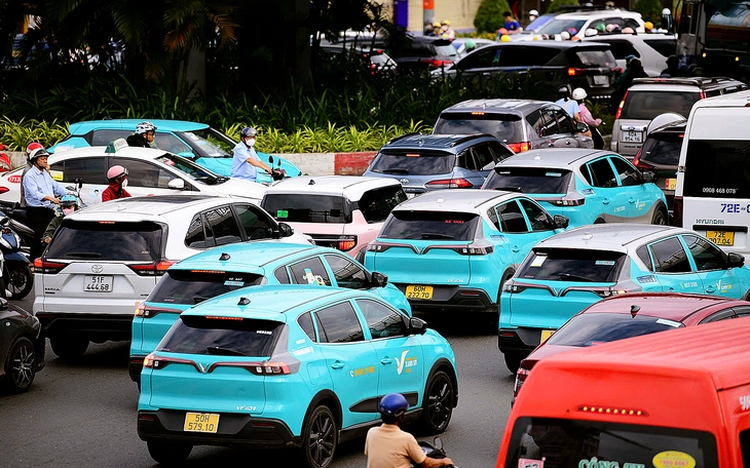
Xanh SM electric taxis transport passengers at Hang Xanh Intersection in Ho Chi Minh City. Photo: Q.Dinh / Tuoi Tre
Ten years ago, Grab disrupted Vietnam’s passenger transport market with its GrabTaxi model, leveraging smartphone-based bookings, aggressive promotions, and driver incentives to outpace traditional taxis.
Soon after, the race saw a flood of new players like Go-Viet (later Gojek), Be, Vato, Mai Linh Bike, Baemin, and ShopeeFood.
At its peak in 2018–19, the market was flooded with promotional money, with drivers receiving weekly bonuses while customers enjoyed daily discounts.
However, the hype was short-lived.
Many local platforms were quickly pushed out due to limited capital and operational challenges, leaving the field to major international players such as Grab, Gojek, Baemin, and ShopeeFood, alongside Vietnamese app Be.
Grab soon evolved into a 'super app' with over 15 services, ranging from GrabCar and GrabBike to GrabFood, GrabMart, and GrabExpress.
Its success was powered by strong data infrastructure—heat map demand predictions, optimized routing, order batching, and an extensive ecosystem of partners from eateries and retailers to small vendors.
According to Grab, the number of merchants on GrabFood alone has increased fivefold compared to 2019.
Partners’ average revenue has tripled compared to 2018, and the productivity of two-wheeled vehicle drivers has risen by 30 percent compared to 2014.
By 2023, however, a shift began as user habits matured and local insight into commuting patterns, residential areas, and peak-hour demand started giving homegrown apps a competitive edge.
That year marked a turning point when Xanh SM entered the market and, within just two years, overtook Grab.
According to Mordor Intelligence’s annual report on Vietnam’s taxi market, by Q4 2024, Xanh SM led the app-based taxi market with a 37.41-percent market share, surpassing Grab’s 36.62 percent and far ahead of Be (5.55 percent), Mai Linh (4.81 percent), and Vinasun (2.44 percent).
This marked a dramatic reversal from 2020, when Grab, Gojek, and Be together held nearly 99 percent of the market share, with 17 local apps sharing just over one percent, according to Statista.
In September 2024, Gojek exited the Vietnamese market, leaving a two-horse race between Grab and Xanh SM.
By Q2 2025, Xanh SM further extended its lead with 44.68 percent of the market, compared to Grab’s 36.08 percent, according to Mordor Intelligence.
Grab has responded with a suite of new features powered by AI, including family accounts, personalized GrabFood collections, restaurant vouchers, pre-booked rides, and international travel packages, announced at its GrabX event in Singapore in early 2025.
Be, holding steady with a nine-percent market share, continues to pursue its 'super app' model with 12 integrated services and over 10 million users.
In 2024, Be saw a 60-percent increase in transaction value and a 50-percent increase in users, with 70 percent using at least two services and spending 25 times more than single-service users.
Be Group recently secured US$30 million and VND740 billion ($28.2 million) in funding from VPBankS, targeting 20 million users and $200 million in gross revenue by 2026.
Meanwhile, other players continue to test the waters.
Tada, entering Vietnam in 2019, still operates in Ho Chi Minh City with a zero-commission policy for drivers.
Lalamove, after eight years in delivery, expanded into passenger transport in August 2024.
Estonia-based Bolt is also preparing to enter, promising no commission and discounts between 20 and 50 percent.


Max: 1500 characters
There are no comments yet. Be the first to comment.